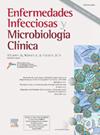分析急诊科要求进行人体免疫缺陷病毒(HIV)血清学检查的原因("Urgències VIHgila "计划的目标筛查策略中定义的原因除外),以及将其纳入未来共识文件的可能性。
IF 2.6
4区 医学
Q3 INFECTIOUS DISEASES
Enfermedades infecciosas y microbiologia clinica
Pub Date : 2024-11-01
DOI:10.1016/j.eimc.2023.12.012
引用次数: 0
摘要
方法 对加泰罗尼亚地区 20 家急诊科两年内进行的所有 HIV 血清学检查进行回顾。因 DC-SEMES-GESIDA 未定义的原因而要求进行的血清学检查按常见疾病分组,计算每种疾病的血清阳性率(95% CI),95% CI 的下限为 0.1% 的血清阳性率被认为是有效的。敏感性分析认为,只有 20% 的就诊病例进行了血清学检查,其余 80% 的病例血清学结果为阴性。结果248 种未被 DC-SEMES-GESIDA 推荐的病症共进行了 8044 次血清学检查,其中 17 种病症的血清学结果为阳性,12 种病症的 HIV 血清学检查有效。检出率最高的是来自艾滋病高发国家(7.41%,0.91-24.3)、淋巴细胞减少症(4.76%,0.12-23.8)、血小板减少症(4.37%,1.20-10.9)、腺病(3.45%,0.42-11.9)、脑膜脑炎(3.12%,0.38-10.8)和吸毒(2.50%,0.68-6.28)的患者。敏感性分析证实了其中 6 项的有效率:来自艾滋病高发国家、血小板减少症、药物滥用、中毒综合征、行为-迷惑-激动障碍和不明原因发热。结论:DC-SEMES-GESIDA 针对急诊室的 HIV 筛查策略可以有效地纳入之前未考虑的其他情况;最具成本效益的情况是来自 HIV 感染率高的国家、血小板减少症、药物滥用、中毒综合征、行为紊乱-迷惑-激动和不明原因的发热。本文章由计算机程序翻译,如有差异,请以英文原文为准。
Análisis de los motivos de solicitud de serología del virus de la inmunodeficiencia humana (VIH) en urgencias diferentes a los definidos en la estrategia de detección dirigida del programa «Urgències VIHgila» y su potencial inclusión en un futuro documento de consenso
Objective
To describe other reasons for requesting HIV serology in emergency departments (ED) other than the six defined in the SEMES-GESIDA consensus document (DC-SEMES-GESIDA) and to analyze whether it would be efficient to include any of them in the future.
Method
Review of all HIV serologies performed during 2 years in 20 Catalan EDs. Serologies requested for reasons not defined by the DC-SEMES-GESIDA were grouped by common conditions, the prevalence (95% CI) of seropositivity for each condition was calculated, and those whose 95% confidence lower limit was > 0.1% were considered efficient. Sensitivity analysis considered that serology would have been performed on 20% of cases attended and the remaining 80% would have been seronegative.
Results
There were 8044 serologies performed for 248 conditions not recommended by DC-SEMES-GESIDA, in 17 there were seropositive, and in 12 the performance of HIV serology would be efficient. The highest prevalence of detection corresponded to patients from countries with high HIV prevalence (7.41%, 0.91–24.3), lymphopenia (4.76%, 0.12–23.8), plateletopenia (4.37%, 1.20–10.9), adenopathy (3.45%, 0.42–11.9), meningoencephalitis (3.12%, 0.38–10.8) and drug use (2.50%, 0.68–6.28). Sensitivity analysis confirmed efficiency in 6 of them: country with high HIV prevalence origin, plateletopenia, drug abuse, toxic syndrome, behavioral-confusional disorder-agitation and fever of unknown origin.
Conclusion
The DC-SEMES-GESIDA targeted HIV screening strategy in the ED could efficiently include other circumstances not previously considered; the most cost-effective would be origin from a country with high HIV prevalence, plateletopenia, drug abuse, toxic syndrome, behavioral-confusional-agitation disorder and fever of unknown origin.
求助全文
通过发布文献求助,成功后即可免费获取论文全文。
去求助
来源期刊
CiteScore
2.10
自引率
8.00%
发文量
194
审稿时长
29 days
期刊介绍:
Hoy está universalmente reconocida la renovada y creciente importancia de la patología infecciosa: aparición de nuevos agentes patógenos, de cepas resistentes, de procesos con expresión clínica hasta ahora desconocida, de cuadros de una gran complejidad. Paralelamente, la Microbiología y la Infectología Clínicas han experimentado un gran desarrollo como respuesta al reto planteado por la actual patología infecciosa. Enfermedades Infecciosas y Microbiología Clínica es la Publicación Oficial de la Sociedad Española SEIMC. Cumple con la garantía científica de esta Sociedad, la doble función de difundir trabajos de investigación, tanto clínicos como microbiológicos, referidos a la patología infecciosa, y contribuye a la formación continuada de los interesados en aquella patología mediante artículos orientados a ese fin y elaborados por autores de la mayor calificación invitados por la revista.

 求助内容:
求助内容: 应助结果提醒方式:
应助结果提醒方式:


